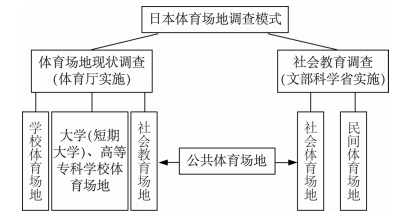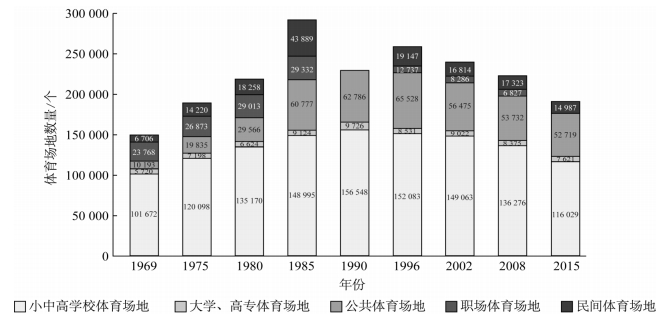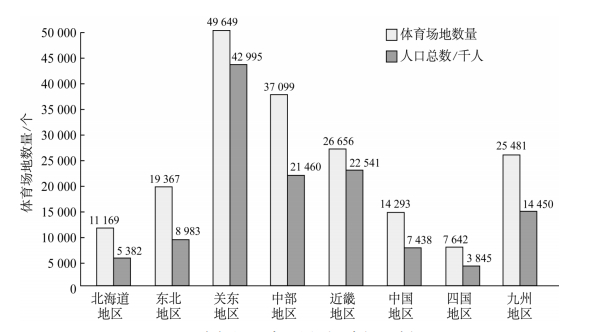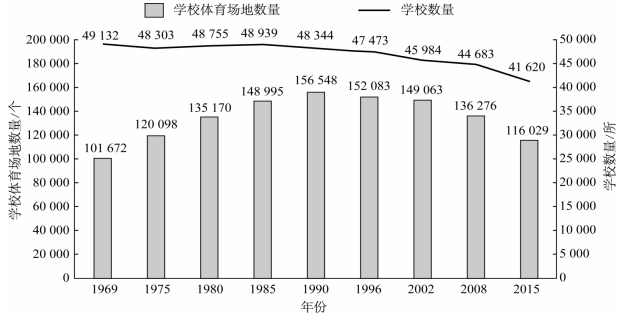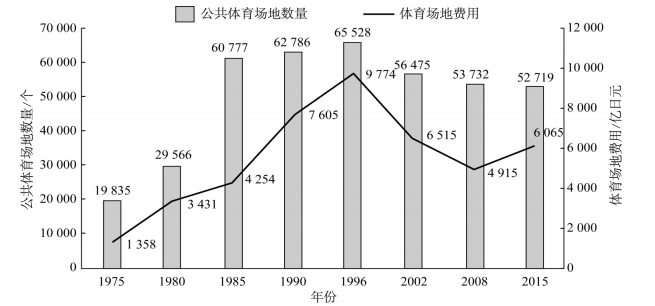Operation Characteristics and Enlightenment of the Development and Management of Sports Field in Japan
-
摘要: 基于日本的全国体育场地普查资料,采用数理统计、对比分析等方法,对日本体育场地的数量与结构变化、地区分布、数量排名、规模特征、指定管理者导入、配建标准、体育指导员配置,以及学校体育场地对外开放的对象、形态、频度等进行统计与比较分析。结果表明:日本的体育场地具有多部门参与建设、鼓励民间投资、整体质量较高、体育空间布局较为完善等优点;但也存在因学校合并、财政支出减少等因素致使场馆数量下降,学校场地预约手续繁琐,部分场地申请使用不便等现实困境。基于分析结果,提出对我国体育场地发展的启示:简化体育场地普查指标,减轻调查工作难度;加强体育场地普查部门合作,建立统计长效机制;转变政府职能,加强场馆市场运营主体培育;协调政府各部门体育场地建设责任,建立联动式目标执行体系;从供给侧优化体育场地资源配置,加强中小规模场馆建设;依托各类场馆成立体育俱乐部,提高公共体育服务品质;引导学校体育场地分类开放,并纳入教育部门考评体系。Abstract: By using the methods of mathematical statistics and comparative analysis, the study explored the quantitative and structural changes of sports field in Japan, its regional distribution, quantity ranking, scale characteristics, importing the designated manager, the standard for construction of sports field, the allocation of sports instructors and the opening object, form, as well as the frequency of school sports fields, etc. It states that Japan has an over-all high quality of sports field operation and sports space layout, with a multiple sectors' participation in the construction of sports field and the prominent nongovernmental investment in sports field. On the other hand, however, there are difficulties including the decline of the number of venues, the complex school sports field booking procedures and usage inconvenience of field application brought about by school merger or reduction of financial expenditure. It puts forward the enlightenment to China as follows:to simplify the sports field survey indicators to reduce the difficulty of investigation; to strengthen the cooperation among the census departments and establish a long-term statistical mechanism; to transform government functions and strengthen the cultivation of market operators; to coordinate the construction responsibility in various government departments and establish a linked target execution system; to optimize facility resources allocation from the supply side and strengthen the construction of medium and small-sized sports venues; to rely on various stadiums to develop sports clubs to improve the quality of public sports services; to guide schools to classify the open of sports field, and integrate into the department of education evaluation system, and so on.
-
1990年之前, 原民主德国(以下简称“东德”)在世界体坛的强势表现, 对于一个“中欧小国”而言可谓是“不可能完成的任务”, 为此很多学者针对东德体育体制和竞技体育的“巨大成功”进行了研究。在东西德合并之前, 大部分文献把东德竞技体育称为“东德奇迹”, 认为国家重视和大量投入、系统选材、注重教练员培养、训练体系完备是实现“东德奇迹”的主要原因[1-4]; 而在合并之后, 尤其爆出东德有组织地服用兴奋剂的丑闻后, 学界对东德竞技体育的研究逐渐减少, 且在有限的研究中, 总体对其持完全否定态度。
那么, 东德是如何将其竞技体育带到世界顶级水平?又如何将这一成绩保持了多年?其间采取了哪些战略方法?兴奋剂是实现“东德奇迹”的唯一手段吗?这些都是研究东德竞技体育值得深入探讨之问题。另外, 对于深受兴奋剂丑闻和政治性体育困扰的东德, 如何客观全面评价其竞技体育成就和竞技体育体制, 对于同样采取“竞技体育举国体制”的我国有着特殊的意义。
1. 东德竞技体育发展回顾
1.1 20世纪50—60年代的目标和方向
东德竞技体育在产生之日起便被赋予了特殊的政治意义, 正如东德体育产生伊始提出的竞技体育2个功能:对外为国际认可而战, 对内为国家统一、社会党合法权利而战[5] 26。这一特殊政治意义在东德竞技体育的历史发展变化中可以得到进一步证实。
20世纪50年代东德竞技体育发展伊始, 其目的是追求国际体坛上的参与机会, 20世纪60年代则致力于与原联邦德国(以下简称“西德”)一起代表整个德国参与国际赛事。竞技体育的目标与方向由起初与西德对抗, 发展为追求竞技体育在国际上的统治地位, 这一变化使东德竞技体育成为对内和对外强有力的政治武器。一方面作为“社会体系之间斗争”的手段之一, 另一方面也是国际社会“和平竞赛”的需要。在此背景下, 20世纪60年代后期东德的竞技水平突飞猛进。其中, 实现这一过程的手段是在国家统一社会党监督之下, 于意识形态框架中, 全面展开竞技体育基础设施和组织机构等方面的工作。竞技体育成为由执政党监督和统治的, 旨在生产运动成绩的社会体系。这一时期东德竞技体育成绩尽管还未在奥运会的层面上表现出来, 但其目标体系和发展方向已形成, 从体制上为竞技体育的高速发展做好了准备。
1.2 20世纪70年代发展的基本特征
鉴于冷战时期竞技体育在国际事务中的地位及其在一些发展中国家的政治意义, 东德从一开始便强调竞技体育的政治作用:对外表现为弘扬国家政治力量, 作为一种获得国际上全面认可的政治手段, 对内激发民众对体育的热情。20世纪70年代以来, 这一政治设计对东德的发展有着特殊意义[6] 286。东德竞技体育从一般的体育运动演变成为国家的突出组成部分和重要的工作任务。通过国家政治和意识形态方面的教育, 培养后备力量成为具有国家意识并在训练和竞赛中为国家荣誉而战的公民。
为提升高水平运动成绩, 东德不但强化人力和物力资源, 同时还完成了竞技体育3个级别的支持体系。3级支持体系由低向高分别为:青少年训练中心和训练基地、体育学校和体育俱乐部、国家队训练基地。1972年支持体系的基础结构于东德各训练中心顺利完成, 该体系吸收了大约近8万名运动员; 同时, 将注意力集中在奥运会拿牌项目的支持设计上, 包括来自财政、物资、技术以及人力资源等方面的强力支持。在上述措施下, 东德竞技体育于20世纪70年代就已达到世界水平, 并在世界赛事尤其是在奥运会上取得了卓越成绩。为保证竞技体育有计划地发展, 东德进一步完善了1973—1976年奥运周期3个级别的支持体系。作为新的组织形式完成了训练基地, 特别是市区训练中心的建设, 并继续完善联络与监控体系的科学基础。其中具有决定意义的举措是实施了对所有年龄段和运动级别运动员完整的医学指导。一方面, 极大地提高了运动员的成绩; 另一方面, 则暴露了东德竞技体育领域有组织和有计划地全面使用兴奋剂的严重问题[6] 290-291。
1.3 20世纪80年代的发展与问题
20世纪80年代是东德竞技体育历史上最辉煌的时期。在3个冬季奥运会和2个夏季奥运会上共获得111枚奥运金牌、98枚银牌和91枚铜牌。取得如此巨大的成就在于支持体系和教育培训体系。到20世纪80年代初期, 该支持体系下的运动员有7万多名。从体育俱乐部选拔出来的混合代表队运动员1 800~2 000人次, 均代表了世界水平。另外有4 200名高水平教练员和9 000名练习教练员致力于运动员的训练工作。在科学指导方面, 科研人员、运动员、教练员、队医及行政人员之间相互合作, 建构了完整的训练和竞赛体系。这一过程可作为体育跨学科工作的典范。上述策略使东德在整个20世纪80年代始终处于世界竞技体育水平的顶端。
东德通过国家力量支持所有竞技体育竞赛项目, 同时将其与其他运动项目分离进行不同的评价, 进而形成了东德一级体育和二级体育的局面。在一级体育领域, 运动员、教练员、体育科学工作者和队医受到高度重视和优厚待遇, 运动员在其运动生涯期间不仅享有丰厚的社会保障, 同时国家还为其提供全面的职业教育培训机会。其本质并不是一个典型的国家对运动员的积极保护行为, 而旨在实现东德竞技体育国际高水平运动成绩。在东德还没有一个领域如竞技体育那样在整个社会系统中享有如此广泛的优越性。这一支持体系下自然要求竞技体育在极短时间内取得突出成绩, 体育科学和运动医学方面的支持也首当其冲, 以至于出现对运动员“药物支持”问题。此外, 体操和体育俱乐部因在行政人员、运动员、教练员以及其他竞技体育方面人员上的巨额开支使国家财政预算方面经常出现严重赤字, 从而导致大众体育的发展逐渐萎靡。这一问题不仅涉及财政和物质方面, 同时也涉及道德方面。
可以说, 东德对竞技体育的大力支持未考虑到运动员的自由发展, 而是将竞技体育作为对外政策运作的工具。尽管在国际竞技体育领域取得了显著成绩, 但对运动员超能力的要求以及通过系统使用兴奋剂所获得的“东德体育的奇迹”和“金牌儿童”等称号并非名副其实[7] 60-63。
2. 东德竞技体育体制
东德竞技体育为政党统一领导, 政党机构、政府部门和社会团体各司其责的结构, 中央竞技体育委员会下设的体育运动秘书处主要负责科研和场馆建设投资; 相关政府部门主要负责学校体育(选材与竞技体育有关)、警察和军队体育; 作为社会团体的东德体育联合会则负责体育俱乐部、行业体育协会、体校、训练中心和东德奥委会(图 1)。东德竞技体育体制是一种效率极高的体制, 作为一个只有1 600多万人口的国家, 能够在奥运舞台上与美、苏2个超级大国争霸就是最好的证明。
![]() 图 1 东德竞技体育体制示意[9]Figure 1. Competitive sports system of East Germany
图 1 东德竞技体育体制示意[9]Figure 1. Competitive sports system of East Germany2.1 东德竞技体育的主要特征
2.1.1 竞技体育成绩融合政治体系需求
东德竞技体育从一开始便被赋予了政治性。早在1948年, 东德体育委员会成立之初的章程中就指出:体育不应以其本身为目的, 而应作为实现目的的一种手段[8]。竞技体育首先服务于国家意识, 并作为东西德抗衡的一种政治手段。在获得国际政治和体育认可后, 东德又将竞技体育作为衡量资本主义和社会主义体系优劣的一个重要标志, 其一直延续至两德合并。为此, 东德成立了统一社会党中央竞技委员会, 作为竞技体育支持的政治基础。所有相关支持措施必须经过统一社会党中央委员会政治局的决议, 包括体育俱乐部、体育协会、科学和技术机构等草案和计划等, 得到批准后方可实行。尤其是把奥运会项目的成绩分析、发展趋势诊断作为未来20年政治和体育发展的依据。每名运动员得到一份个人成绩合同, 包括未来奥运会和其他世界性竞赛[10]。
东德竞技体育决议有3种不同形式:① 每4年起草1份奥运会分析报告, 并应用于下届奥运周期中(这一形式在1961年就已存在); ② 确定一个长达12年和20年的竞技体育发展方针和实践效果要求(这一形式在1969年就已存在); ③ 自1970年, 增加和实施中期评价, 作为前2种决议的总结分析和再要求。东德竞技体育政策政治性导向极为明显, 诸如资金、兴奋剂及由此产生的运动员的健康问题等被一味地掩盖, 试图谋求国际竞技体育的霸权地位。竞技体育体系发展成为东德政治体系中的一个子系统, 政治体系对其拥有绝对监督权力。
2.1.2 竞技体育领域的两极分化
为在竞技体育领域尤其是在奥运会上获得更好的成绩, 东德在运动项目支持上采取了重质量而非数量的发展策略, 将资助集中到“拿牌”项目上。对单一的奥运会竞赛项目的重视使东德开始出现竞技体育的“两极分化”, 形成“一级体育”和“二级体育”的发展局面。奥运会、世界和欧洲冠军赛以及欧洲其他赛事只是“一级体育”组织中运动员的专利, “二级体育”领域的运动员根本无机会。其中“一级体育”的拿牌项目获得优厚的财政和人员支持。另外, 对“一级体育”有一个完整、严格以及有组织的支持体系。其基础是通过发掘有天赋的儿童和青年运动员, 再通过学校、地区、州和国家的青少年运动会, 激励青少年参与运动和竞赛。青少年运动会的竞赛项目集中在“一级体育”范畴内。
2.1.3 竞技体育资金的大量投入
为谋求竞技体育在国际上的霸权地位, 东德对竞技体育投入逐年上升。1951年投入至体育的财政仅有600万马克, 至1960年达到1 900万马克。之后以每年5%~10%的速度递增[11] 246-256。东德政府到底投入了多少资金到竞技体育中, 其准确数字迄今为止难以计算。根据德国学者艾尔谢特的估算, 1988年东德全年体育经费的投入为15亿德国马克(约合75亿元人民币), 这其中有40%直接分配给竞技体育, 其余60%在名义上给群众体育, 但实际上有很多用在支持青少年体育运动的部分资金是间接为竞技体育服务的[12] 52。另外, 在对竞技体育大量的资金支持中还出现了多次无法估量的错误性计划和在某些项目上的巨大浪费。东德几乎所有的体育工作都围绕“奥运战略”展开。根据1980年的统计, 仅1 600万人口的东德, 拥有体育场329个, 运动场1 172个, 小型运动场9 582个, 体育馆4 154个, 游泳馆186个以及滑雪跳台331个。仅1975—1980年就新建约2 700个体育设施[13]。这些场地的修建和维护耗资巨大。
2.2 东德竞技体育体系
东德竞技体育体系涉及青少年运动会、后备人才培养、青少年体育学校、体育俱乐部和科研支持等要素。按照当时东德专家的看法, 竞技体育要取得巨大的成就必须依托完善和高效的后备力量选拔和支持体系[14] 116, 对后备力量有计划地选拔和发展是竞技体育发展的主要基础[15] 112。东德尝试在强化措施下进行后备力量的选拔以及进一步认识训练的组织和方法, 不仅包括后备力量的选拔, 也包括高水平运动员的选派; 不仅涉及体育运动本身, 同时要按照政治立场选派和支持。东德竞技体育后备人才培养在国际上曾一度成为典范。
2.2.1 青少年运动会
借鉴苏联经验, 东德在后备力量培养方面注重青少年运动会, 从而为青少年体校选拔人才。自1965年起, 东德青少年运动会分别在夏季和冬季举行, 包括4个阶段:预赛(按年级、学校及地方进行)、乡镇运动会、区运动会和国家运动会。按照这一形式, 青少年运动会逐渐发展成为东德竞技体育后备力量的选拔赛。在国家、地方、学校等方面的宣传下, 青少年儿童踊跃参加运动会, 并以此为荣。上百万青少年儿童最后只有11~12万人次能通过地区选拔, 冬季项目则更少, 只有1 000人次左右通过。青少年运动会的组织实施一般通过社会力量, 如在一些义务工作者和志愿者的帮助下进行, 国家不进行投入。东德青少年儿童运动会不仅是对体育运动的激励, 同时也是青少年儿童政治和行为教育的手段[16] 111-113。在追求竞技体育国际地位的影响下, 青少年运动会的组织也被强迫划分为“一级体育”和“二级体育”, 并且体操和体育联合会将青少年运动会的比赛项目缩减至参加奥运会的几个优势项目上。那些在“二级体育”领域的青少年基本上没有机会赢得运动会的胜利, 取胜者往往是来自体校和训练中心的青少年。
2.2.2 后备人才的培养
在对青少年儿童的培养方面, 东德通过所谓统一观察和挑选的方法, 借助于学校支持, 系统地在学生中挑选有潜质的运动员, 并及早选派到训练中心接受训练。在一些诸如艺术体操等项目中, 满4周岁的儿童便开始接受训练。后备人才的选拔方法和内容极为完备, 如1973年东德通过了《体操和体育联合会训练中心和训练基地后备力量选拔方法》, 其中规定在一年级时进行粗略选拔, 三年级时进行重复选拔, 从而挑选出有发展潜力的青少年儿童。体育教师、体育俱乐部教练员在选拔过程中肩负责任。一年级仅测量身高、体重等体质参数, 三年级则进行60 m跑、跳远、三级跳远、耐力跑、俯卧撑、铅球投掷等项目测试。另外, 中学生器械体操的成绩和青少年儿童的生理发育指标也被列入参考范畴。
训练中心是青少年体育支持的准备阶段, 任务是保证青少年儿童通过3~4年进行多样性的、适合运动项目发展的基础教育, 为青少年体校和俱乐部训练做准备[14] 127。训练中心、体育学校和体育俱乐部是东德竞技体育支持体系的第一级别和第二级别。这一统一选拔方法至20世纪80年代后, 逐渐暴露出缺陷:一方面, 拒绝将子女引领到竞技体育发展道路上的家长增多; 另一方面, 越来越多有天赋的运动员由于政治性原因或运动成绩下滑以及健康原因被开除或淘汰。由此, 东德竞技体育人才的统一选拔方法逐渐失去活力(图 2)。
![]() 图 2 东德竞技体育支持级别模型[15] 15Figure 2. Model of supportive level of competitive sports in East Germany
图 2 东德竞技体育支持级别模型[15] 15Figure 2. Model of supportive level of competitive sports in East Germany2.2.3 青少年体育学校
东德竞技体育拥有严格的保密措施, 就连青少年体育学校也不对外全面公开。青少年体校的组织和结构曾一度鲜为人知, 对外只是简单介绍, 留给外界尤其是来自西德等西方国家的只是一种假象, 甚至东德强调青少年体育发展的种种困难, 其完整和有成效的竞技体育体系一直处于保密状态。东德青少年体育学校严密的组织性及其训练的统一性使其逐步发展成为一个卓有成效的培育竞技体育主力队员的“冶炼工厂”[7] 31。
20世纪50年代初期, 在柏林、莱比锡、布兰登博尔格等东德城市已有了青少年体育学校[16] 121。家长可以不经过选派将12岁以上有运动天赋的子女送到学校进行常规性训练。随即青少年体育学校遍布开来。1959年后, 东德全民教育部通过决议将青少年体育学校改为“青少年体育特殊学校”, 集中于城市发展。此外, 政府还建立了寄宿学校, 完善了集训练、教学、食宿为一体的完整结构设施。在体育学校中, 青少年儿童既要完成高水平的运动训练, 同时又要完成学校教育任务。
为了解决学生学习和训练竞赛等方面的压力和矛盾, 政府在对师资进行大量投入的同时, 为学生运动员提供特殊的学习计划, 不过竞技训练的意义远远超过一般学校的教育任务。尽管如此, 青少年运动员还是承担着巨大的负荷和压力, 很多运动员由于各种原因退出体育学校。尤其是20世纪80年代后, 尽管东德尝试通过重新选派和挑选运动员等方法巩固原有基础, 但有天赋的青少年运动员基于各方面的原因以每年5%~10%的比例退出训练。主要原因在于:体育学校制定的较高成绩发展目标与相对缺乏成绩发展的前提条件之间的矛盾加剧。一方面, 后备力量过早专业化与训练过程不断提高的运动负荷不相适应; 另一方面, 青少年缺乏科学训练方法的指导。终止运动生涯的学生中将近一半以上是由上述原因引起的[17] 33。
2.2.4 体育俱乐部
作为第3个支持等级, 体育俱乐部构成东德竞技体育主力金字塔的塔顶。尽管青少年运动学校培养后备运动员并输送至体育俱乐部, 最后却只有近1/3的运动员达到最高水平[15] 126。各体育俱乐部在组织和结构方面无本质上的区别, 所有俱乐部隶属于体操和体育联合会。经体育学校培养, 被体育俱乐部接收的高水平运动员分为3级。其中主力1级代表国家在俱乐部进行训练和竞赛, 主力2级为国家队优秀后备力量, 主力3级只作为储备。
统一社会党中央委员会早在1969年有关竞技体育的决议中规定了体育俱乐部的训练内容, 俱乐部和教练员必须按照决议要求运行并为之负责。运动员的训练由教练员制定, 但须接受俱乐部监督; 教练员的训练方法须与俱乐部的训练计划一致, 独立的训练方法只有在保证取得成绩的条件下方可被有限使用。训练一般通过相对应的一个夏季奥运周期或冬季奥运周期组织。其中, 通过加大训练次数、范围和强度, 逐渐提高运动负荷和运动成绩是重要的训练方式。除此之外, 高水平运动员的个人训练计划在运动训练中也尤为重要。例如, 速度滑冰项目曾获得莱比锡体育学院的科研支持。在不同阶段的个人训练计划中, 通过对运动员的个人诊断确定训练和竞赛目标, 运用特别的周期性训练设计为运动员能够达到最高的竞技状态做充分准备。
东德在竞技体育全方位的财政支持上一直保守秘密, 就连体操和体育联合会的工作人员也不清楚财政支持的各个细节[9]。财政资助对俱乐部运动员是有区别的, 一般倾向于主力运动员。例如, 主力运动员除了普通的月收入外, 还有不同程度的成绩补助费用以及参加国际竞赛或课程、训练班的日常补助费用。对于在国际比赛中获得冠军的运动员还将得到高额奖金。除此之外, 取得优异成绩的运动员将获得国家勋章, 并通过奖金的形式给予鼓励。为了获得物质和职业方面的保障, 每个运动员在其竞技体育职业生涯伊始必须以书面的形式签署一份个人服从国家竞技体育事业的协议。除此之外, 获得资助的运动员必须与东德的政治和道德要求相符合。
2.3 东德竞技体育的科研支持
为保证竞技体育在国际上的优势地位, 东德非常重视体育科研, 强调科学认识在实践中的应用。东德竞技体育体系拥有科研全方位的支持, 体育科学和运动医学的中心任务是有效地参与和进一步优化竞技体育, 具体包括[18]:① 利用科学方法进行后备人才选拔; ② 后备人才的系统发展; ③ 高质量的教练员培训; ④ 健康指导和社会指导; ⑤ 训练计划的科学优化实施; ⑥ 运动专项研究; ⑦ 各措施间的协调。
科研支持和科学训练是东德竞技体育的特色之一, 通过科研支持使训练方法得到改进与创新、运动训练理论得到发展。如果能从生物学和训练学角度对具体的事例进行论证会更有说服力, 由于本文主题的限制和缺少相应的文献资料, 未能在这方面进行深入研究, 这是后续研究的一个重点。
2.3.1 德国体育大学(东德莱比锡体育学院)
以苏联模式成立的德国体育大学曾是东德竞技体育的科学中心, 拥有1 000多名教师, 培养了众多优秀教练员, 80%以上的毕业生成为训练中心或俱乐部的教练员。德国体育大学的专业分为体育教育、体育心理学、体育史、体育政治、数学和信息学、俄语和机密保护、测量和评价技术、运动医学、生物力学以及训练方法等。学校还设立了函授和进修课程。科研方面, 集中在生物力学、生理和训练学等领域中的研究。为防止科研成果外泄, 尤其在备战1972年奥运会期间, 严禁对外公开体育科研成果, 其竞技体育理论和实践杂志甚至不对学院内部学者开放, 以此防止新的科学理论和科研成果向外传播。
2.3.2 东德体育研究所
为促进竞技体育的科研支持力度, 东德在莱比锡体育学院成立了体育研究所, 标志着体育科学研究与教学的进一步分离。科学研究的目的也不再探讨科学认识和基础研究, 而是进一步提升东德竞技体育运动成绩, 尤其是集中在一些优势项目和拿牌项目上。体育研究所在严格保密状态下进行竞技体育的科学研究工作, 超过20个专业的大约600名专家和学者参与其中。他们的工作任务是按照奥运会周期, 通过“科学先行工作”保证东德运动员获得高水平的运动成绩。其科研工作集中在以下5个方面[18]:① 改善力量发展的肌肉刺激研究; ② 力量训练仪器的研发; ③ 对运动员即刻施加影响的带有即刻数据反馈的测量训练; ④ 在隔离的生物化学实验室进行的合成代谢和中心刺激手段实验; ⑤ 训练竞赛中心理调整方法的发展和实验。
2.3.3 东德竞技体育运动医学服务
运动医学对东德体操和体育联合会3个支持级别的所有运动员进行指导工作, 并重视运动项目在一般和特殊的运动医学指导中的区别, 是涉及不同训练要求和成绩结构以及训练和竞赛后运动能力恢复的专门组织过程。这一特殊任务要求对相关的体育科学知识, 如成绩诊断、功能诊断以及对不同运动项目的研究进行整体把握。运动医学指导主要在各单一体育俱乐部的框架中进行, 尤其是对当时奥运会的19个竞赛项目加以区分, 并进行专门的运动医学指导活动, 为此产生了一个从一级到三级的运动医学指导体系[19]。此外, 来自不同医学领域专家组成的医学顾问团体专门为高水平运动员服务, 建立运动员运动医学指导的地区范围体系。
尽管东德对高水平运动员所做的指导工作非常全面, 但后来还是不断地尝试医学药物对提高运动成绩方面的实验, 并且在运动员中广泛应用。虽然德国的一些学者如舒曼明确指出, 运动医学的科学和实践工作首先应加强对运动员健康方面的保护[15] 144, 然而, 东德非但没有拒绝使用兴奋剂, 反而通过一些组织机构, 如东德体育研究所, 在竞技体育领域计划和组织了不计其数的以提高运动员成绩为目的的药物项目研究。
3. 对东德竞技体育体制的评价
3.1 正面评价:竞技体育举国体制
短短40多年, 东德竞技体育就登上了世界体坛的巅峰, 这是由诸多因素造就的。东德的竞技体育体制是名副其实的“举国体制”, 即以政党主管、国家投入、统一选材和集中训练为特色的竞技体育体制。执政党统一社会党非常重视体育运动的发展, 尤其是竞技体育的激励和宣传作用, 这种指导思想甚至被写入宪法, 使竞技体育成为宣传和强化意识形态的工具, 对巩固执政党的领导有积极而重要的作用[1, 12]。这一服务于国家政治的特性始终贯穿东德竞技体育的发展过程之中。
从20世纪60年代末开始, 东德竞技体育体系内部隐藏了2个转向过程。一是通过了多个政治局决议, 使东德竞技体育产生了本质性变化。竞技体育在体育政策的高标准要求下构建, 享受持续性的国家支持, 如完善和科学的个人跟踪训练。通过特殊规定的学校和职业教育, 全方位的专人指导以及固定的经济和物质刺激等。高水平运动员获得社会、物质和财政方面的特别支持。此外, 对世界竞技体育统治地位的一味追求, 竞技体育作为对外政策的手段及社会主义与资本主义之间阶级斗争的一个固定组成部分而受到政府格外关注。另一转向体现在训练方式上。运动员经受了竞技体育体系的严格要求, 从而为东德在国际上取得显著的成绩打下基础; 但统一社会党在竞技体育决议中对运动员运动成绩的要求不断提高, 使运动员训练规模不断扩大, 导致了在训练中心或青少年运动学校青少年运动员的超负荷训练。20世纪80年代后, 在加大运动量已无法持续的情况下, 又将注意力集中到提高训练强度上。
总而言之, 东德利用强有力的政治手段, 形成了高效运作的竞技体育体制, 在明确的目标导向下, 一直处于世界体坛的领先位置。
3.2 负面评价:兴奋剂阴云
东德竞技体育训练过程的药物支持在广义上被理解为能提高运动员的负荷承载能力, 并在超强度的训练和竞赛后迅速恢复的一种广泛措施; 而在狭义上同时在国际上已被认为使用了兴奋剂[19]。直到东西德合并后, 东德还一直强调对运动员的药物支持和兴奋剂无丝毫关系, 但很多材料证实东德运动员使用了兴奋剂。德国学者施皮策对东德退役运动员进行过跟踪研究, 结果表明大约10 000名后备运动员和高水平运动员曾遭受强制性使用兴奋剂, 而且多数是在无意识的情况下“被使用”。这其中有超过1 000人次在身体和精神上受到严重损害, 很多运动员的子女也出现了非偶然性损害[20] 18-19。
1974年后, 鉴于国际竞赛组织对兴奋剂检测技术和方法的不断完善, 东德在兴奋剂方面着手进行一个更为秘密的研究计划和监督体系:一方面, 保证兴奋剂继续秘密使用; 另一方面, 将兴奋剂检测的危险降至最低。统一社会党对兴奋剂使用和实施过程进行严格监督, 尤其是东德体育研究所凭借其独立的工作团体不断地进行药物的研发工作, 特别是新物质的研发[21] 343-366。国家体育秘书处作为责任机构, 供给充足资金, 保障兴奋剂研究。同时协作相关政府部门, 包括卫生部和科学部门, 不仅进行计划和设计, 还组织了一个由体育学者、医生以及自然科学工作者组成的秘密研讨会, 就一些重大问题进行有针对性的研讨。20世纪70年代后期, 随着国际兴奋剂检测水平的加强, 一些使用合成类制剂的东德运动员被检查出兴奋剂阳性结果后, 东德的兴奋剂专家则进行了更为精确的兴奋剂研究。除了睾酮, 运动员还被注射一个准确剂量的表睾酮, 以此隐蔽人工合成的荷尔蒙附加物, 使运动员在竞赛前可以继续服用违禁药物而无法被查出。东德于1984年冬季奥运会上在遴选的运动员中进行了大剂量的睾酮注射, 同时注射表睾酮, 完成所谓的运动员竞赛前的准备工作[16] 179。
东西德合并后, 对东德竞技体育兴奋剂的讨论逐渐强化, 并出现了一些介绍东德竞技体育领域使用兴奋剂的文献和资料。鉴于反兴奋剂呼声高涨, 东德于1989年11月着手调查兴奋剂事件, 并将大量关于运动员使用兴奋剂方面的文章, 包括来自大学的博士论文和俱乐部档案迅速销毁或隐藏。尽管如此, 仍有超过150份关于兴奋剂问题的材料被保护起来, 这些材料成为东德竞技体育系统使用兴奋剂的确凿证据[22]。德国学者弗兰克和施皮策介绍了东德竞技体育领域使用药理学手段的特征[20] 24-25:① 东德竞技体育兴奋剂的使用是在运动员个人或小组无意识的状态下, 由中央委员会决议, 通过体育俱乐部进行的全面的兴奋剂计划和章程; ② 兴奋剂的研究、分配和应用涉及几乎所有运动项目; ③ 通过著名医生和科学工作者参与的, 无视运动员健康, 由国家规定的非道德、非法的人体试验。其中近1/4药物未经过副作用检测; ④ 基于对竞技体育成绩的无限制追求, 东德不仅违背了国际体育规则, 同时也违背了医学道德法规以及医务人员自身的法律规定(处罚法规和药品法规)。
3.3 全面评价
如果把东德竞技体育的辉煌成就简单归结为“有组织、有预谋地使用违禁药物”, 这个结论并不客观, 对东德也不公平。
(1) 使用违禁药物并非东德运动员的专利, 在其他体育强国如美国、苏联和东欧一些国家, 甚至我国在20世纪90年代时也有不少使用违禁药物的案例, 说明使用违禁药物在全球范围内都是比较常见的用以提高运动成绩的手段。进入21世纪后爆出的主要兴奋剂丑闻事件多发生在美国。例如女子短跑运动员琼斯、男子短跑运动员蒙哥马利、男子自行车运动员阿姆斯特朗等, 从这些“英雄”运动员的“药罐子”事件可以看出, 美国现在俨然已成了兴奋剂问题的“重灾区”。然而, 无人会质疑美国世界竞技体育最强国的地位, 因为人们的注意力更多地集中在美国的竞技体育体制上, 即以学校竞技体育为基础、以职业体育为抓手的“社会主导型”竞技体育体制。生活在这种体制下的美国青少年运动员, 学习、训练、接受大学教育和未来就业都得到保障。因此, 人们认为兴奋剂问题偶尔出现, 甚至在目前出现相对比较多的情况下, 也不能掩盖美国竞技体育体制本身所发挥的作用, 美国还是世界竞技体育强国。
(2) 东西德合并之后德国竞技体育尤其是夏季奥运会成绩下降, 主要原因不是因为运动员不再服用违禁药物, 而是因为德国沿用了西德的竞技体育体制, 即俱乐部体制, 在这种体制下只有最受欢迎、比较流行的项目才能保持高水平。东西德合并之后, 东德的竞技体育体制如同其社会体制和经济体制一样, 完全被西德所取代。在西德的俱乐部体制下, 受大众欢迎的、流行的运动项目发展机遇好, 如足球、曲棍球、马术、赛艇、自行车、击剑和大多数冬季项目就保持了比较好的发展势头; 而田径和游泳虽然也是德国人比较喜欢的运动项目, 但流行程度稍差一些, 缺少了类似东德“举国体制”的强有力支持, 尽管有天才式的运动员带动, 如比德曼和斯蒂芬, 但总体水平较东德下滑得比较严重。皮划艇项目是一个特例, 西德的水平比较低, 在奥运会上甚至一块奖牌都拿不到, 也算不上流行的项目。两徳统一后, 由于保留了大量东德的教练员继续执教, 先前的选拔、训练体系得以维持。尽管缺少了所谓的“药物支持”, 但通过高效的训练, 德国皮划艇从原来西德的弱势项目变为优势项目, 在近3届奥运会上均获得7~8枚奖牌, 在皮划艇项目奖牌榜上遥遥领先(表 1)。对这个特殊现象的解释, 恰恰能够说明取得好成绩的根本因素在于体制保证下的训练水平, 而不是简单地依靠违禁药物。
表 1 汉城奥运会和近3届奥运会部分项目德国所获奖牌数 枚Table 1. Medals of some sports in Seoul and other 3 Olympic Games for Gemmany国家 奥运会 奖牌数/枚 田径 游泳 皮划艇 东德 1988年汉城奥运会 27 28 9 西德 1988年汉城奥运会 4 3 0 德国 2008年北京奥运会 1 2 8 德国 2012年伦敦奥运会 8 1 8 德国 2016年里约奥运会 3 0 7 基于以上分析, 东德竞技体育的成功不能简单地归结为“药物支持”, 而是得益于高效的竞技体育“举国体制”。东西德合并后, 由于德国未继承东德竞技体育体制中的优点, 如集中选材、集中训练和重视科研等, 导致德国竞技体育总体实力有所下降尤其是夏季奥运会成绩下降较多。故东德作为“举国体制”最具代表性的国家, 其竞技体育取得辉煌的主要原因在于体制, 而不是靠违禁药物。违禁药物只是东德发展到极致的竞技体育“举国体制”下的一种副产品或催化剂, 在一定程度上帮助“举国体制”发挥出了更大的“威力”。
4. 结束语
20多年后再看东德的竞技体育体制, 既不是20世纪90年代前普遍认同的“巨大成功”和“体制带来的奇迹”, 也不是20世纪90年代后专家学者们认为的“完全失败”和“丑陋不堪”, 而是成功经验和失败教训并存, 对我国现有体制有很大启示的前车之鉴。很多学者把目前我国的竞技体育体制称为举国体制, 但同东德比起来, 我国的体制还不能算真正的举国体制, 因为我们并未达到像东德那样“举全国之力”办竞技体育的程度。另外, 一般认为我国的举国体制存在动力源不足、多种利益矛盾突出、资源浪费严重、运动员出口不畅等方面的弊端[23], 因此改革甚至彻底改变举国体制的呼声很高。
对东德竞技体育体制及德国统一后竞技体育发展特点和趋势的分析看, 带给我国竞技体育的启示在于:我国的竞技体育已获得了丰收(至少在夏季奥运会上), 已成为夏季奥运强国, 这说明举国体制是提高我国竞技体育成绩最有效的手段。如果完全放弃举国体制, 必然会造成部分项目水平的急剧下滑, 尤其是在我国开展并不普及、群众基础较差的一些优势项目如举重、跳水、体操和射击等。故从竞技体育可持续发展的角度首先应继续坚持和完善举国体制, 以提高在重大国际赛事尤其是奥运会中为国争光的能力, 弘扬奥林匹克精神和中华体育精神。此外, 在完善举国体制的同时, 应优化发展模式, 这一模式主要针对球类集体项目的提高和体育市场的完善, 尤其是对足球等带动体育产业发展以及社会影响力大的项目[24]。如此, 将有效改善我国竞技体育目前存在的诸多顽疾, 使我国从夏季奥运强国逐渐转变为竞技体育强国, 从而达到体育强国在竞技体育方面的标准和要求。
-
表 1 日本体育场地的主管部门分布
Table 1 Relevant departments in charge of sports field in Japan
主管部门 相关法令 体育场地类型 文部科学省 学校教育法 学校体育场地(小学、中学、大学、中等教育学校、特别支援学校、专修学校、短期大学、高等专科大学) 体育基本法社会教育法地方自治法 社会体育场地公立社会教育场地(公民馆、青少年教育设施、女性教育设施等附带的体育场地) 厚生劳动省 身体障碍者福祉法 残疾人体育场地(残疾人福利中心体育场地、残疾人体育场地、残疾人教养文化体育场地) 国土交通省 都市公园法 都市公园(棒球场、田径场、游泳馆等) 道路法、交通安全设施等事业推进相关法律 车站附近的场地 农林水产省 国有林野管理经营法 娱乐森林(森林体育林、野外体育区) 环境省 自然公园法 国立公园、国家公园中的体育场地 资料来源:参考文献[4]。 表 2 日本体育场地数量排名前10位的类型
Table 2 Types of top 10 sports field in Japan
序号 场地类型 数量/个 占比/% 累积占比/% 1 体育馆 43 022 22.48 22.48 2 多功能运动场 39 189 20.48 42.96 3 室外游泳池 25 714 13.44 56.40 4 室外网球场 15 090 7.89 64.29 5 棒球场 9 147 4.78 69.07 6 柔剑道场(武道场) 7 360 3.85 72.92 7 训练场 5 778 3.02 75.94 8 其他体育场地 4 971 2.60 78.54 9 室内游泳馆 4 384 2.29 80.83 10 柔道场 3 352 1.75 82.58 注:根据2015年日本体育场地调查数据制作而成。 表 3 日本各类型体育场地规模情况
Table 3 Sports field scals in Japan
序号 场地类型 总计 规模Ⅰ 规模Ⅱ 规模Ⅲ 数量 同类占比/% 数量 同类占比/% 数量 同类占比/% 1 体育馆 43 022 7 973 18.5 23 753 55.2 11 296 26.3 2 多功能运动场 39 189 16 510 42.1 16 652 42.5 6 027 15.4 3 室外游泳池 25 714 1 724 6.7 5 924 23.9 18 066 70.3 4 棒球场 9 147 4 723 51.6 2 380 26.0 2 044 22.4 5 柔剑道场(武道场) 7 360 3 484 47.3 3 488 47.4 388 5.3 6 室内游泳馆 4 384 1 072 24.5 1 056 24.1 2 256 51.4 7 柔道场 3 352 1 282 38.2 1 796 53.6 274 8.2 8 球技场 3 130 1 344 42.9 819 26.2 967 30.9 9 剑道场 2 919 1 786 61.2 1 001 34.3 132 4.5 10 高尔夫球场 2 344 1 994 85.1 350 14.9 — — 11 田径场 1 840 1 086 59.0 497 27.0 257 14.0 注:根据2015年日本体育场地调查数据制作而成。体育馆:规模Ⅰ≥1 300 m2,规模Ⅱ=660~1 299 m2,规模Ⅲ=132~659 m2。多功能运动场:规模Ⅰ≥10 000 m2,规模Ⅱ=4 000~9 999 m2,规模Ⅲ=992~3 999 m2。室内外游泳场馆:规模Ⅰ≥10 000 m2,规模Ⅱ=400~999 m2,规模Ⅲ=150~399 m2。棒球场:规模Ⅰ≥10 000 m2,规模Ⅱ=6 600~9 999 m2,规模Ⅲ≤6 599 m2。柔剑道场(武道场):规模Ⅰ≥400 m2,规模Ⅱ=200~399 m2,规模Ⅲ≤199 m2。柔道场:规模Ⅰ≥128张,规模Ⅱ=40~127张,规模Ⅲ≤39张。球技场:规模Ⅰ≥10 000 m2,规模Ⅱ=6 400~9 999 m2,规模Ⅲ≤6 399 m2。剑道场:规模Ⅰ≥200 m2,规模Ⅱ=67~199 m2,规模Ⅲ≤66 m2。高尔夫球场:规模Ⅰ≥18洞,规模Ⅱ=9~17洞。田径场:规模Ⅰ=400 m跑道,规模Ⅱ=201~399 m跑道,规模Ⅲ≤200 m跑道。 表 4 日本公共体育设施指定管理者导入状况
Table 4 Designation of managers of public sports facilities in Japan
体育场地类型 2015年数量 指定管理者 2015年导入数量 2015年占比/% 2008年占比/% 田径场 911 556 61.0 49.6 棒球场 6 855 2 957 43.1 37.0 球技场 1 587 882 55.6 50.3 多功能运动场 8 501 2 882 33.9 27.3 室内游泳馆 1 766 1 137 64.4 50.5 室外游泳池 2 061 989 48.0 31.3 体育馆 8 777 3 675 41.9 35.0 柔道馆 829 438 52.8 42.2 剑道馆 720 398 55.3 43.8 柔剑道场(武道场) 1 158 489 42.2 32.4 室外网球场 5 204 2 432 46.7 37.9 室内网球场 217 101 46.5 47.0 弓道场 1 154 587 50.9 43.0 训练场 1 907 1 287 67.5 58.8 其他体育场地 11 000 5 308 48.3 40.7 总数 52 719 24 139 48.0 37.9 注:根据2008、2015年日本体育场地调查数据制作而成。 表 5 日本体育场地配备体育指导者状况
Table 5 Configuration of Japanese sports instructors
序号 场地类型 公共体育场地 民间体育场地 场地总数 配备指导者场地数 占比/% 指导者人数 场地总数 配备指导者场地数 占比/% 指导者人数 总数 专任 兼任 总数 专任 兼任 1 田径场 911 70 7.68 225 37 188 15 1 6.67 4 - 4 2 棒球场 6 855 174 2.54 354 43 311 158 6 3.80 11 3 8 3 球技场 1 587 179 11.28 250 53 197 356 113 31.74 417 283 134 4 多功能运动场 8 501 223 2.62 596 84 512 214 54 25.23 414 144 270 5 室内游泳馆 1 766 1 985 112.40 4 719 2 753 1 966 1 520 1 338 88.03 16 300 11 428 4 872 6 室外游泳池 2 061 168 8.15 822 485 337 72 34 47.22 280 151 129 7 体育馆 8 777 954 10.87 3 108 1 177 1 931 320 158 49.38 1 099 568 531 8 柔道馆 829 47 5.67 165 24 141 177 104 58.76 359 260 99 9 剑道馆 720 125 17.36 144 31 113 156 82 52.56 272 229 43 10 柔剑道场(武道场) 1 158 76 6.56 242 94 148 33 16 48.48 64 36 28 11 室外网球场 5 204 513 9.86 621 197 424 730 322 44.11 1 483 911 572 12 室内网球场 217 14 6.45 47 6 41 303 240 79.21 2 066 1 422 644 13 训练场 1 907 1 809 94.86 3 631 1 785 1 846 1 606 1 268 78.95 10 735 5 669 5 066 14 营地 1 693 157 9.27 317 148 169 371 47 12.67 138 100 38 总计 42 186 15 241 6 917 8 324 6 031 33 642 21 204 12 438 注:根据2015年日本体育场地调查数据制作而成。 表 6 日本学校体育场地对外开放状况
Table 6 The opening rate of sports field in Japan's schools
场地类型 学校类型 2015年场地总数 2015年开放数 2015年开放率/% 2008年开放率/% 室外运动场 小学 17 669 15 702 88.9 87.2 中学 8 052 6 013 74.7 77.4 高等学校等 4 341 1 910 44.0 47.1 总计 30 062 23 625 78.6 80.0 体育馆 小学 17 998 17 216 95.7 95.1 中学 8 341 7 669 91.9 90.0 高等学校等 4 361 1 595 36.6 40.3 总计 30 700 26 480 86.3 87.3 游泳池(室内/室外) 小学 12 044 3 649 30.3 34.0 中学 4 581 481 10.5 14.6 高等学校等 2 650 156 5.9 7.3 总计 19 275 4 286 22.2 26.7 室外网球场 小学 400 35 8.8 15.7 中学 3 470 613 17.7 16.8 高等学校等 2 900 642 22.1 18.4 总计 6 770 1 290 19.1 17.4 注:根据2008、2015年日本体育场地调查数据制作而成。 表 7 日本学校体育场地对外开放状况
Table 7 The opening objects of sports field in Japan's schools
场地类型 学校类型 开放场地数 本校学生开放型 大众开放型 限于学区(校区) 不限于学区(校区) 团体 个人 团体 个人 开放校数 占比/% 开放校数 占比/% 开放校数 占比/% 开放校数 占比/% 开放校数 占比/% 室外运动场 共计 23 625 279 1.2 4 025 17.0 356 1.5 13 412 56.8 5 279 22.3 小学 15 702 237 1.5 2 929 18.7 289 1.8 8 463 53.9 3 655 23.3 中学 6 013 18 0.3 938 15.6 64 1.1 3 435 57.1 1 424 23.7 高等学校等 1 910 24 1.3 158 8.3 3 0.2 1 514 79.3 200 10.5 体育馆 共计 26 479 215 0.8 4 545 17.2 458 1.7 15 520 58.6 5 593 21.2 小学 17 216 173 1.0 3 190 18.5 365 2.1 9 813 57.0 3 650 21.2 中学 7 669 17 0.2 1 252 16.3 89 1.2 4 490 58.5 1 740 22.7 高等学校等 1 594 25 1.6 103 6.5 4 0.3 1 217 76.3 203 12.7 游泳馆(室内/室外) 共计 4 286 1 570 36.6 424 9.9 264 6.2 1 086 25.3 936 21.8 小学 3 649 1 433 39.3 370 10.1 246 6.7 846 23.2 785 21.5 中学 481 119 24.7 45 9.4 16 3.3 145 30.1 128 26.6 高等学校等 156 18 11.5 9 5.8 2 1.3 95 60.9 23 14.7 室外网球场 共计 1 290 71 5.5 115 8.9 9 0.7 781 60.5 312 24.2 小学 35 - - 7 20.0 - - 20 57.1 4 11.4 中学 613 49 8.0 85 13.9 9 1.5 254 41.4 194 31.6 高等学校等 642 22 3.4 23 3.6 - - 507 79.0 114 17.8 总计 55 680 2 135 3.8 9 109 16.4 1 087 2.0 30 799 55.3 12 120 21.8 注:根据2015年日本体育场地调查数据制作而成。 表 8 日本学校体育场地开放数量与频度
Table 8 The opening and frequency of sports field in Japan's schools
年份 场地开放校数 全年定期开放 全年不定期开放 学校假期开放 周一至周五 周六 周日 全年≥10 d 全年≤9 d 全年≥30 d 开放校数 占比/% 开放校数 占比/% 开放校数 占比/% 开放校数 占比/% 开放校数 占比/% 开放校数 占比/% 2015 55 680 33 427 60.0 35 672 64.1 34 375 61.7 9 647 17.3 4 137 7.4 5 093 9.2 2008 66 532 37 690 57.1 38 424 57.8 37 048 55.7 11 906 17.9 4 792 7.2 3 790 5.7 注:根据2008、2015年日本体育场地调查数据制作而成。 -
[1] 日本文部科学省体育厅.体育基本计划2017-2022[Z].东京: 文部科学省, 2017: 1 [2] 日本文部科学省.体育·スポーツ施設現況調査の概要[R].东京: 文部科学省, 2015: 3-4 [3] 神部純一.大津市立公民館の事業に関する調査[J].调査研究, 2014, 6:70 [4] 日本文部科学省. スポーツ施設に関する調査研究事業(平成27年度)[R].东京: アビームコンサルティング株式会社, 2015: 5 [5] 彭锐, 刘皆谊.日本避难场所规划及其启示[J].新建筑, 2009(2):102-106 doi: 10.3969/j.issn.1000-3959.2009.02.021 [6] 周强, 夏正清.日本国民体育大会研究[J].体育文化导刊, 2012(10):41-45 doi: 10.3969/j.issn.1671-1572.2012.10.011 [7] 日本总务省统计局.人口推計の結果の概要[EB/OL].[2019-01-12]. https: //www.e-stat.go.jp/ [8] 日本总务省.地方公共団体コード一覧表[EB/OL].[2019-01-12]. http://www.tt.rim.or.jp/~ishato/tiri/code/code.htm [9] 日本总务省统计局.平成27年国勢調査人口等基本集計結果[R].东京: 总务省统计局, 2016: 9 [10] 罗平.日本公共体育设施运营的指定管理者制度及启示[J].上海体育学院学报, 2010, 34(6):22-26 doi: 10.3969/j.issn.1000-5498.2010.06.006 [11] 高军, 南尚杰, 李安娜.日本公共体育设施指定管理者制度分析及启示:基于政府职能转变的视角[J].上海体育学院学报, 2016, 40(6):30-36 http://d.old.wanfangdata.com.cn/Periodical/shtyxyxb201606005 [12] 日本体育协会.公認スポーツ指導者制度[R].东京: 日本体育协会, 2017: 6 [13] 胡启林.日本竞技体育发展策略研究[J].武汉体育学院学报, 2017, 51(6):95-100 doi: 10.3969/j.issn.1000-520X.2017.06.015 [14] 林建君, TEO Eechon.中日学校体育场馆设施开放利用分析及启示[J].宁波大学学报(人文科学版), 2015, 28(3):127-132 http://d.old.wanfangdata.com.cn/Periodical/nbdxxb201503026 [15] 何金廖, 张修枫, 陈剑峰.体育与城市:德国城市绿色空间与大众体育综合发展策略[J].国际城市规划, 2017, 32(5):44-48 http://d.old.wanfangdata.com.cn/Periodical/gwcsgh201705007 [16] 日本文部科学省体育厅. スポーツによる地域·経済の活性化[EB/OL].[2019-01-12]. https://www.asoview.com/brand/sports-tourism/ [17] 日本文部科学省.体力·スポーツに関する世論調査[R].东京: 健康スポーツ課, 2013: 50 [18] 日本文部科学省.文部科学白書2005[EB/OL].[2019-01-12]. http://www.mext.go.jp/b_menu/hakusho/html/monbu.htm [19] 日本总务省统计局.学校基本调查报告[R/OL].[2019-01-12]. http://www.mext.go.jp/b_menu/toukei/chousa01/kihon/1267995.htm [20] 樊道明, 王子朴.中外体育财政问题比较研究[J].北京体育大学学报, 2008, 31(12):1616-1692 http://d.old.wanfangdata.com.cn/Conference/7110368 [21] 陈元欣, 王健.我国公共体育场(馆)发展中存在的问题、未来趋势、域外经验与发展对策研究[J].体育科学, 2013, 33(10):3-13 doi: 10.3969/j.issn.1000-677X.2013.10.001 [22] 日本总务省.地方財政統計年報[EB/OL].[2019-01-12]. http://www.soumu.go.jp/iken/zaisei/toukei.html [23] 日本文部科学省.学校体育施設等の有効活用実践事例集[R].东京: 文部科学省スポーツ·青少年局, 2012: 8 [24] 日本东京都教育委员会.都立学校体育施設開放利用について[EB/OL].[2019-01-12]. http://www.kyoiku.metro.tokyo.jp/buka/shogai/taikushisetsu.htm [25] 日本大阪府都市整備部都市計画室公園課. オーパス·スポーツ施設情報システムガイドブック[R].大阪: 都市整備部都市計画室公園課, 2017: 9 [26] 张贵峰.八成成年人何以"从不锻炼身体"[J].云南教育(视界综合版), 2012(9):37-38 http://www.cnki.com.cn/Article/CJFDTotal-YNJB201209023.htm [27] 陈元欣, 王华燕, 张强.体育场地统计长效机制构建[J].上海体育学院学报, 2017, 41(2):36-41 http://www.wanfangdata.com.cn/details/detail.do?_type=perio&id=shtyxyxb201702007 [28] 国家体育总局经济司.第六次全国体育场地普查数据汇编[EB/OL].[2019-01-12]. http://www.sport.gov.cn/pucha/index.html [29] 国务院.国务院关于印发全民健身计划(2016-2020年)的通知[EB/OL].[2019-01-12]. http://www.gov.cn/zhengce/content/2016-06/23/content_5084564.htm -
期刊类型引用(5)
1. 赵全华. 民国时期山东省第一届国术省考述论. 河北开放大学学报. 2024(04): 7-13 .  百度学术
百度学术
2. 王家宏,董宏. 文化自信视域下中国式体育现代化要素内涵式发展方略研究. 天津体育学院学报. 2022(06): 626-631 .  百度学术
百度学术
3. 陈希. 传统武术在近代文化融合中的失语研究. 武术研究. 2020(04): 24-27 .  百度学术
百度学术
4. 覃宏荣. 浅谈初中政治教学中的快乐教学法. 教育界. 2019(02): 152+156 .  百度学术
百度学术
5. 庞博,张子华,纪仲秋,姜桂萍. 健康中国背景下民间游戏的价值与国际化推广对策研究. 四川体育科学. 2019(05): 87-92+103 .  百度学术
百度学术
其他类型引用(2)





 下载:
下载:

